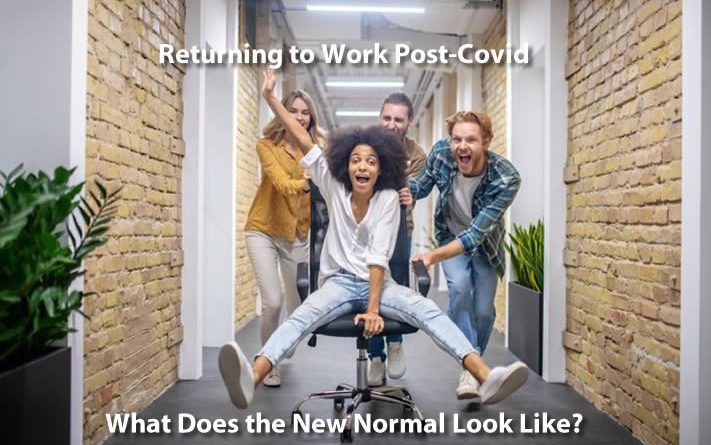Returning to Work Post-Covid – What Does the New Normal Look Like?
Returning to Work Post-Covid – What Does the New Normal Look Like?
As Covid-19 vaccination programs ramped up all over the nation, you’ve probably seen some states start to reopen. And with those reopenings, you’ve probably also heard of, if not experienced, businesses returning to in-person status. With that return, you’ll almost certainly have heard of that strange phrase, “the new normal.” But what does it mean?
When it comes to a return to work, it means a lot. As Forbes reports, “before the pandemic, 20% of workers worked from home all or most of the time. As of late 2020, more than 70% of workers were doing all or most of their job from home.” When we return to work under the new normal we are likely to see more workers continue to work from home. In a survey conducted by LiveCareer, 61% of its respondents said they want their employer to continue to let them work remotely, even after the pandemic. In fact, many employees report better work-life balance, greater flexibility, and higher productivity in a work-from-home setting.
While productivity and cost-efficiency of working at home may be debatable, it looks like the new normal will provide a continued level of at-home employment. This will include choosing to do so permanently or to work in a hybrid schedule — a mix of at-home and face-to-face interaction.
This may be a necessary step in our return to work as variants of the virus leave employers planning for stricter protocols to protect workers against infection. Workspaces will certainly almost change to allow for greater distancing and less employee density. This may result in a need for some workers either to stay home or to work on rotating schedules so that fewer employees are in the office at the same time. Indeed, a survey conducted by Willis Towers Watson shows that 56% of companies responded that they had already reconfigured workspaces due to the pandemic.
Another potential major change for those who are used to working in one large, central location is that businesses may transition to several satellite offices instead. As Halley Knigge, a representative of REI said, “We also found ourselves with the opportunity to reexamine some past assumptions – like the need for a single physical headquarters.” Instead, the company will build several smaller offices around the Puget Sound area where it is based.
Numerous shifts will be in focus in the new normal
There are, of course, some changes that the new normal is likely to create in the workplace. Some of the shifts that you may encounter are:
- Monitored workspace: Because of concerns about space, areas such as conference rooms and elevators may be monitored to ensure safe distance requirements.
- Focus on hygiene: you might see continued health vigilance, including temperature checks, the use of ultraviolet light to sterilize mail, hand sanitizing stations, and portable rapid air-purifiers.
- Touchless technology: you may see expected changes such as motion-activated faucets, soap dispensers, towel dispensers, and toilets, but you may also see such technology bleed over into innovative coffee dispensers activated by a QR code and by automated lunch ordering with staggered pick up times.
- A new emphasis on outdoor spaces: While not every climate will allow for working outside, if you work in a temperate area, you may see a shift toward using outdoor spaces for work and meetings.
So much now is unpredictable until we see how quickly vaccinations can be completed and until we know more about the virus variants and the vaccine’s efficacy against them. But Covid-19 has certainly taught us that we would benefit from caution as we move forward. The new normal then is likely to be a work environment that feels very different from what we knew only a short year ago.
—
Ivan Young is a writer for Happy Writers, Co. in partnership with Seattle Fabrics, a recreational fabric retailer.

